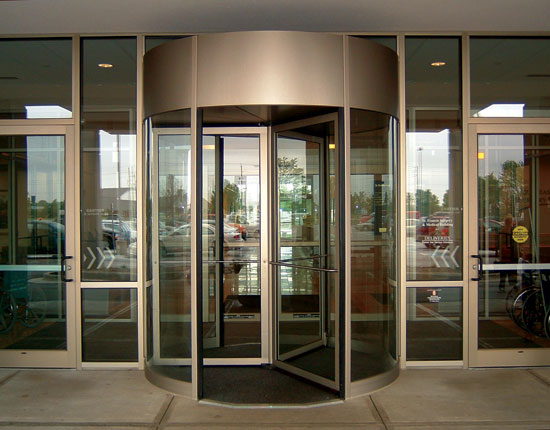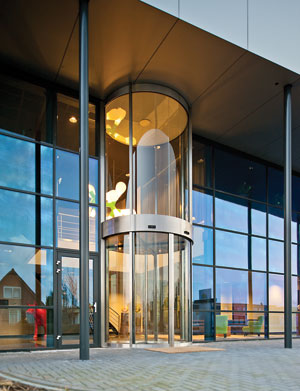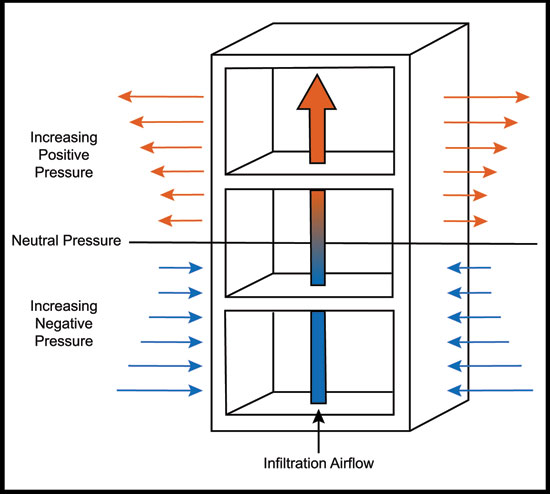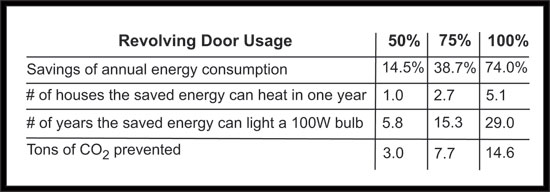The Ins and Outs of Revolving Doors
Not only can revolving doors efficiently handle bi-directional pedestrian traffic and reduce energy costs by maintaining an airlock, they improve comfort for building occupants and offer more usable space at building entrances compared to vestibules—all attributes that have been proven for more than 125 years. Revolving doors were invented in Philadelphia in 1888 by American-born Theophilus Van Kannel to reduce air infiltration. “As the door fits snugly in the casing,” Van Kannel's 1888 patent states, “it is perfectly noiseless in its operation and effectually prevents the entrance of wind, snow, rain or dust either when it is closed or when persons are passing through it.” The original motto of Van Kannel's company was “Always open, always closed,” that is, always open to people, always closed to the elements.

Image courtesy of Boon Edam
For a clean look, architects can specify stainless steel or other type of metal.
A basic understanding of the way air behaves in a building sheds light on the benefits of revolving doors. Generally speaking, air flows in and out of a building because of differences in air pressure and humidity in what is known as the stack effect. In the winter, heated air rises toward the top of a building and as long as there are any openings on the ground floor, cold air rushes in to replace the heated air. The opposite happens in the summer, with the cold air flowing out the front doors. In addition, air flows through the building when doors, vents, or windows are open; this is known as a wind tunnel effect. Regular foot traffic through swinging or sliding doors can result in air leaks of up to thousands of cubic feet per minute, requiring more air to be heated or cooled.

Image courtesy of Boon Edam
Dimensional elements can be selected to create a distinctive look.
Granted, a revolving door isn't airtight, but the barrier it creates makes the impact of that air pressure differential less important. Every time the door spins, some air will leave the building and some will come in, but overall, much less passes through a revolving door than a swing door. Not only are drafts eliminated, noise and air pollution minimized, and dirt and debris kept out of the building, but revolving doors also counter the effects of stack pressure, which increases in taller buildings. Where stack pressure is prevalent, the ease of operation of pushing a revolving door compared to pulling or pushing hinged or swinging doors is another key driver in selecting a revolving door system as the primary point of entry.
Energy Saved by Revolving Doors: The MIT Study
In 2006, a team of graduate students at MIT conducted an analysis of door use in one building on campus, E25, where they found just 23 percent of visitors used the revolving doors. According to MIT's calculations, the swinging door allowed as much as eight times more air to pass through the building than the revolving door. According to the April 2009 MIT Tech Talk publication, “Research from MIT students indicates that if everyone were to use the revolving doors in Building E25, for example, MIT would save almost $7,500 in natural gas a year. That's enough to heat five houses over the same timeframe, and it also adds up to nearly 15 tons of CO2.”
According to the study, the revolving door stops conditioned air from moving freely. In contrast, an open swing door is like letting go of a balloon—the air rushes out of the opening. With a revolving door, only the air in the chamber with the person going through the door is transferred. The accompanying figure illustrates how air is transferred in and out of a building. Cold air is more dense than warm, resulting in a pressure differential (“stack pressure”) that moves conditioned air through open doors and cracks in seals. Wind blowing on the building adds to this pressure differential.

Image courtesy of Boon Edam
The MIT findings on how revolving door usage affects energy consumption are shown in the accompanying table. It is worth noting that if all people entering and exiting the building under study used revolving doors, the energy savings would be 74 percent, preventing the release of more than 14 tons of CO2. However, these energy savings do not amount to 88 percent, as might be expected from the eight times less air transferred through the revolving door as through the swing doors. That is due to the fact that the revolving doors leak more than swing doors, lowering their overall efficiency slightly.

Image courtesy of Boon Edam
Energy savings depend on the weather. Heating is less efficient than cooling, and the indoor/outdoor temperature differential is larger in the winter than in the summer, so more energy is saved in the winter. Windy days are worse than calm ones. Still, every time a user walks through a door and feels that rush of “wind,” they are feeling energy leave the building.
The accompanying chart (see the online version of this course) shows monthly-averaged total air leakages through MIT's Building E25 doors, with a revolving door usage of 23.3 percent. The watt-hour (symbolized Wh) is a unit of energy equivalent to one watt (1 W) of power expended for one hour (1 h) of time. The watt-hour is not a standard unit in any formal system, but it is commonly used in electrical applications.

Image courtesy of Boon Edam
Research showed that the average heat transfer per swing door passage is 78Wh (267 BTU), or the equivalent of 1.3 hours of light from a desk lamp; 4.3 hours of light from a compact fluorescent bulb; driving a car 306 feet; or jogging half a mile. Revolving doors, on the other hand, show reduced air infiltration, which translates to less energy wasted and consequently greater financial savings. Industry watchers maintain that revolving doors perpetually save money for the owner, with an average payback period of two to five years.

Image courtesy of Boon Edam









